News
![Part 3:The Evolution of the TRX Foundational Movements [Lunge to Step]](http://www.trxtraining.com/cdn/shop/articles/claudia-step-edit_960x.jpg?v=1644298488)
Part 3:The Evolution of the TRX Foundational Movements [Lunge to Step]
The TRX Foundational Movements were created to provide a baseline of knowledge for understanding and teaching movement patterns that are fundamental to both athletic training and to everyday life. Each one—from the plank to push to the pull to the squat, etc—create the base for the hundreds of movements we utilize in any given environment, using any number of training tools (again, these movements map to almost everything we do). We teach these concepts in depth in our TRX education courses in order to enable you to properly and effectively coach any person (regardless of their skills) using any modality.
TRX’s movement-based coaching philosophy focuses largely on seven Foundational Movements (Plank, Push, Pull, Hinge, Lunge, Squat and Rotate), understanding that they can and will be expanded on as one progresses. In this blog series, we flip our traditional script a bit and discuss the evolution of these movements. If you haven’t had a chance to read the two previous blogs in the series: Part 1, Hinge to Bend and Part 2, Twist to Rotate, we highly suggest you do before diving into Part 3.
If you’re all caught up, then let’s get into the next installment: Lunge to Step - step being the “new” movement we’ll be introducing.
ABOUT THE LUNGE
In the gym, the lunge is a popular unilateral movement, providing an excellent way to recognize imbalances in strength and/or mobility. The lunge is a versatile exercise that has infinite variations and can be performed in all ranges of motion to target the musculature in different ways. For instance, lunges provide the foundation for walking, running, sprinting, climbing, and most bipedal locomotion. When you improve the way you lunge, you can improve your efficiency in any activity that involves lower body acceleration and deceleration.... Powerful stuff. When lunging, focus on maintaining stability from the ground, through the core, up through the top of the head, to enable mobility in the ankles, knees, and hips. Seems simple enough...
In the TRX Education Journey, we discuss the lunge in our TRX Suspension Training Course (setting the standards on and off the TRX Suspension Trainer), our Functional Training Course (where we expand the coaching to multiple functional training tools), and then again in the TRX Group Training Course (where you learn to coach the standards of this movement in a group environment).
THE STEP VS THE LUNGE
While we discuss the lunge throughout our TRX Education Courses, its counterpart: the step, is a great addition to add to your knowledge base as a coach. The primary reason we teach the lunge first is to ensure we train our clients or athletes how to decelerate (ability to slow movement down as the body lowers to the ground) before we move into acceleration exercises, which is where the Step comes in. While the lunge is used to promote deceleration, the step is the agent for acceleration, driving through the ground and into hip, knee, ankle, and metatarsal extension. In the world of TRX Suspension Training, a good example of the step is the TRX Sprinter Start, where you start from a strong standing plank position, and through the addition of a hip extension, then driving through the ball of the foot, squeeze the glutes ,and extend forward to create acceleration.
Although the step can be taught as a “progression” to a lunge, it can also be used as a great unilateral exercise entry point for those who struggle with knee pain during lunges.
STEP MECHANICS
Step mechanics should mirror squat-to-stand mechanics in that one of the primary cues for both is to drive through the ground as the body extends. To break this down, as you stand, the shin should remain parallel to the trunk; the goal of the step is to create the appropriate amount of range of motion with load distributed through the torso. If we go back to what we learned in our TRX Education Courses, the movement standard for the step is defined by what should be stable and what should be mobile -the spine should be stable and the hips, knees, ankles, and metatarsal heads should be mobile. To bring in even more TRX terminology, an applicable TRX Swing Thought (our imagery based cueing system to help your clients better understand and correct their faults) in the case of the step would be “body like a surfboard”, as we want them creating an active plank with a tall torso throughout the movement.
HOT TIP: EARN YOUR PROGRESSION
Stepping exercises should be introduced without any external load. Load can be added when the client is able to perform with optimal mechanics. For instance, keep your eye out for minimal—if any—wobbling. When the client has earned their progression, and adding load is appropriate, you can change the condition by adding dumbbells or kettlebells, and/or by adjusting the tempo. But keep in mind, it’s important to change only one condition at a time as to minimize risk and maximize client confidence and proficiency.
SAMPLE “STEP” EXERCISES TO INTEGRATE INTO YOUR WORKOUTS:
TRX Sprinter Start:
TRX Hamstring Runner:
Some additional exercises to try are Box Step-ups and/or Sled exercises.
FINAL NOTES:
When all is said and done, training programs should be tailored to meet the needs of the individual - and every progression must be earned. As the old saying goes, “learn to walk before you run.” The same goes for movement sessions. Certainly turning a step-up into a step-up-and-jump combo is more exciting and fun, but with the increased intensity comes increased risk. If you’ve been through our Education Courses the acronym FLAC should be familiar to you. FLAC stands for: FOCUS on the movement, LEARN the appropriate level of progression, APPLY the training load, CHALLENGE your goals. This is an amazing rule of thumb to take into consideration when you’re creating a workout. Bottom line: your goal should be to select the appropriate level of exercises that keep your clients safe, injury-free, and confident during their workouts - and most of all, to always analyze your choices and then determine if the potential “reward” is actually worth it.
Check out the next blog in this series: Part 4, Plank to Crawl.
To learn more about movement-based training, check our the TRX Education Journey.
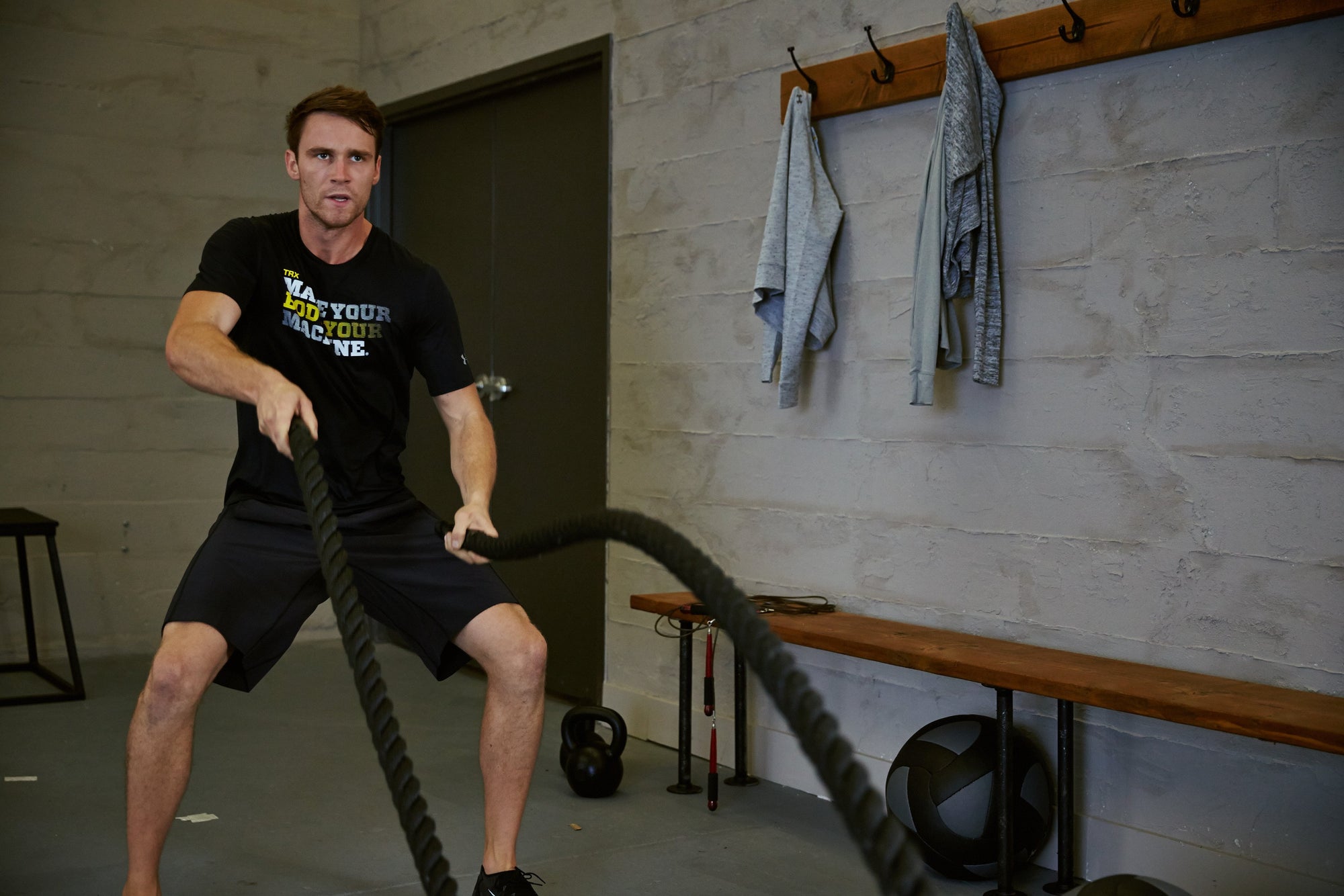
The Conditioning Rope Challenge
Conditioning Ropes (also known as battle ropes) have emerged on the training scene over the past ten years in large part thanks to the pioneering programming work of John Brookfield with Ingrid Marcum. While conditioning ropes still remain on the fringe of the mainstream, this style of training continues to gather momentum and popularity.
There are a number of different ways to utilize Conditioning Ropes (generally a rope that is 1.5” in diameter and 40’ to 50’ long) but for the purpose of this article we will be looking at the most common use for them dubbed the velocity / wave principle by Brookfield and Marcum. This involves using an upper body movement to send a wave or series of waves down the length of the rope toward it’s anchor point.
I began integrating the modality into my own training about 8 years ago and like many, I utilized them primarily for short duration, high intensity interval bouts, experiencing good success and activating a type of training that previously had not been possible.
This was until I had the opportunity to talk with my friend, the aforementioned Ingrid Marcum about how much fun I was having involving conditioning ropes in my workouts and she offered the following input.
The conversation went a little like this…
Ingrid: “… Well if you’re using them at all you really should be able to do them for 20 minutes.”
Me: (incredulously) “IN A ROW?!”
Ingrid: (casually) “Yup”
Me: (in disbelief) “Surely you’re using different arm patterns and stances?!”
Ingrid: (still casually) “No… alternating waves, hip to shoulder amplitude, about 120 waves per minute and each wave has to hit the anchor point”
Me: “Oh…” (read - “You must be out of your DAMN MIND!!”)
Ingrid: “If you can do it continuously for 4 min you can do it for 20”
Me: “WHAT?!”
Ingrid: “Seriously… you should try it! It’s a fun challenge!”…
At that point I excused myself from the conversation and essentially ran away. I honestly thought that she was properly pulling my leg but still… What if?…
Two weeks later toward the end of March, there I was - out in the melting snow on a field near my home in the Canadian Rockies with the intent on giving it a try.
So while I was dumb enough to try it, I was smart enough to set my timer to a series of 20 intervals consisting of 40 sec work with 20 seconds rest. My plan was to go for as long as I could continuously and then fall back to the :40 on / :20 off intervals when the wheels inevitably fell off the wagon so that I could finish out the 20 min.
So how did it go?…
Let’s say it wasn’t long before I retreated to the intervals and it didn’t get much better from there. While I was able to make the 20 minutes using the intervals, to call it “U-G-L-Y” would have been kind.
In retrospect while I had been near haughty about my “retreat to the timer” strategy I was too obtuse to realize that using a battle rope on a field of melting snow would result in the rope getting wet… which, as it turns out, means HEAVY. Oh yes… and grass is a high friction surface!
It would be weeks before this realization would come to me, as at the time I was directing all blame squarely toward Ingrid and her “stupid challenge.”
Fast forward about 6 weeks, on May 11th (my birthday) I received the following public Facebook message from Ingrid…
“Happy Birthday!…Finished that challenge yet? ;-)” Nice. Calling me out on my birthday… some friend she is!
OK - so it worked. And not only did her motivational strategy work, in that I re-engaged with the challenge, but I also had some amazing learnings:
1) 20 minutes of continuous battle rope is not only possible, but actually reasonable.
2) If you can do 4 minutes consecutively you actually CAN do 20 minutes.
3) It is a tremendously effective cardiovascular and muscular endurance based functional and athletic workout, with added benefits of core strength and mental tenacity.
4) You cannot understand the nuances and movement efficiencies of this type of training without marching through the hard miles of continuous work.
This last point is an incredibly important one! I found that after completing the challenge of sustained battling rope work, my ability to perform high intensity rope based intervals was significantly elevated due to all of the movement efficiencies that I had learned during my continuous efforts. I was more efficient in my moment and therefore more effective when it came time for high output efforts.
Now having completed the challenge I often perform the 20 minutes as a component of my regular workouts, modifying it at times to include alternate upper and lower body motor patterns to create the waves or layer intense intervals within the continuous work.
I also often use shorter sustained efforts of 5 to 10 minutes as a method for movement prep and maintain that it is one of the best modalities to improve shoulder and rotator cuff health.
I firmly believe that it is some of the best athletic and coordinative training available that has exceptional carry over to many common activities. The benefits of this training style truly go on and on!
So how does one bite off such an initially daunting challenge?
Step 1: Make a kick ass playlist to keep you motivated and help you mark the time.
Note: If you select music that adheres to about a 120 bpm count you will be able to utilize it as an intensity meter as well
Step 2: Use one of the many timer apps (I use “Seconds Pro”) to help you progress to the full continuous 20 minutes
Step 3: Follow the following training progression where you successfully complete each stage with high movement quality before leveling up to the next.
Perform these workouts ideally twice per week and not more than 3 times and you will be amazed how quickly your abilities improve and you achieve the challenge.
This internationally renowned expert is a founding member of the revolutionary training company TRX® and an award winning presenter who’s been featured at conferences and events all over the world including an appearance on the TEDx stage. Fraser combines an animated, entertaining style with his knowledge and gift to motivate and inspire. His provocative writing and presentations have been known to stretch the minds of his audiences and provide relevant and effective training solutions in a practical setting.
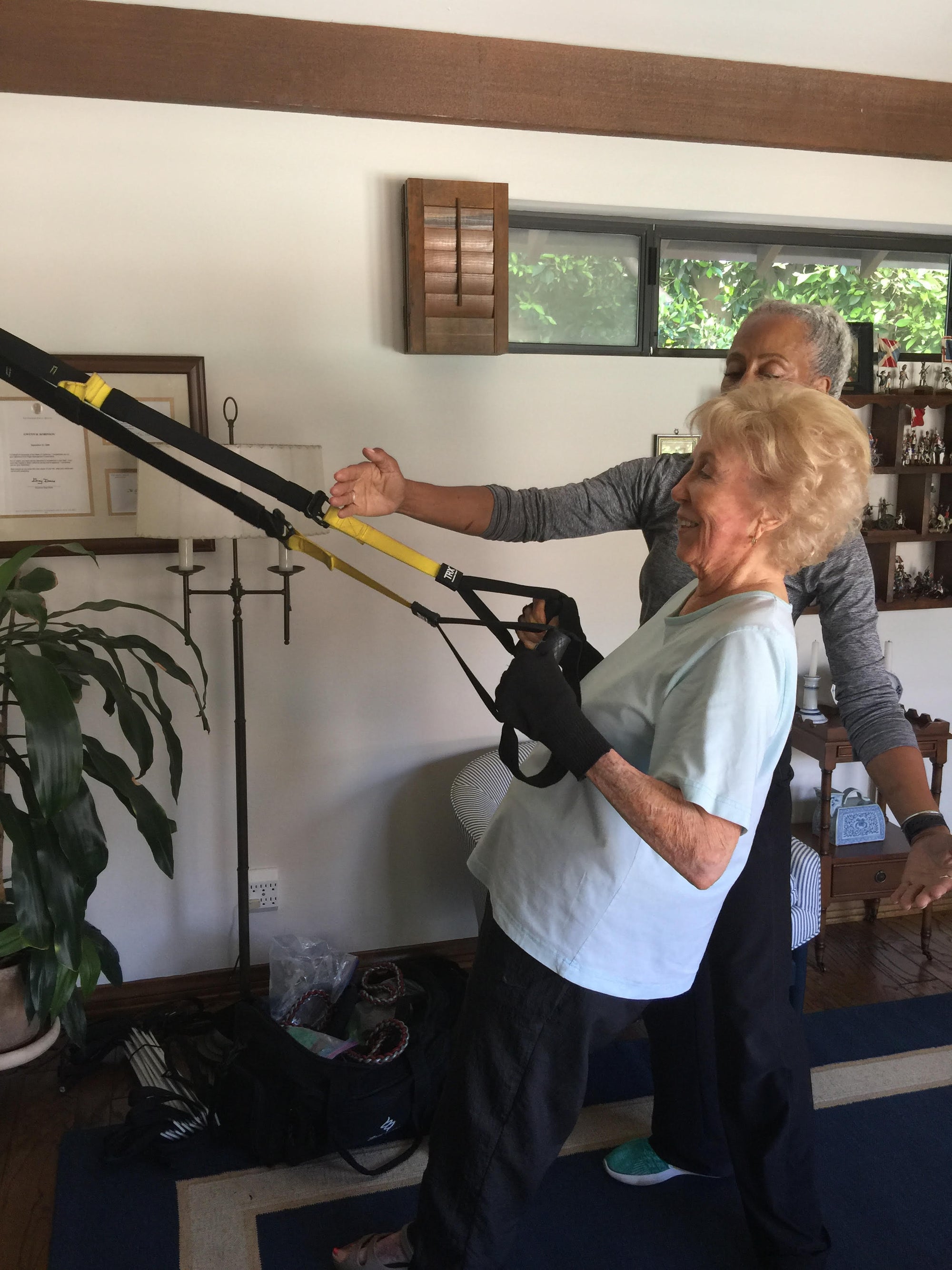
The Best Fitness Gift for Grandparents
Selecting a gift for a grandparent is nerve-wracking. You want to find something useful, novel, and considerate that doesn’t create more clutter. And if it helps improve their quality of life? That’s a pretty satisfying bonus. It’s rare to find something that can meet all those criteria, but the TRX Suspension Trainer checks every box. Here are five reasons why the Suspension Trainer is the best fitness gift for a grandparent.
First, the Suspension Trainer saves time and money. TRX’s Home2 System comes with everything necessary for a full-body workout. It’s easy to set up on a door, tree, or pole, and—if you’re shopping for a tech-savvy senior—the TRX App is full of pre-programmed workouts to try with the tool.
Second, this is a compact, yet comprehensive tool. TRX fans love the Suspension Trainer because they can literally use it anywhere. It comes with a mesh carrying pouch, and it weighs less than two pounds, so it’s easy and practical to pack in a suitcase.
Third, the Suspension Trainer works for every athlete at every fitness level. It’s just as effective for someone trying to improve balance and mobility as it is for an 85-year-old Supreme Court justice who works out regularly with a trainer. (Yes, Justice Ruth Bader Ginsburg uses TRX in her workouts.)
Fourth, this is a “no excuses” tool. Let’s face it: cold or rainy days can interfere with the best of workout intentions. If your grandparent has a habit of skipping the gym, bring the gym to your grandparent. You don’t have to empty a room or drill a mount into a wall to set up a TRX home gym.
Finally, strength training is really important for senior citizens. It can delay age-related muscle loss, strengthen bones, improve mobility and function, prevent falls, and help combat depression and cognitive decline. A Wake Forest University study published last year found that strength training was more effective than cardio for older adults.
Grandparents are a gift, and you want them to live long, active lives. But good health takes effort and the right tools: As your grandparents age, the TRX Suspension Trainer can help them stay stronger and mobile longer. (TRX even has workouts specifically designed for older adults.) The Suspension Trainer is a present they’ll use time and again, which is why it’s the best fitness gift for grandparents.
And if you’re still shopping for other folks on your holiday list, check out the Ultimate TRX Holiday Gift Guide for more ideas.
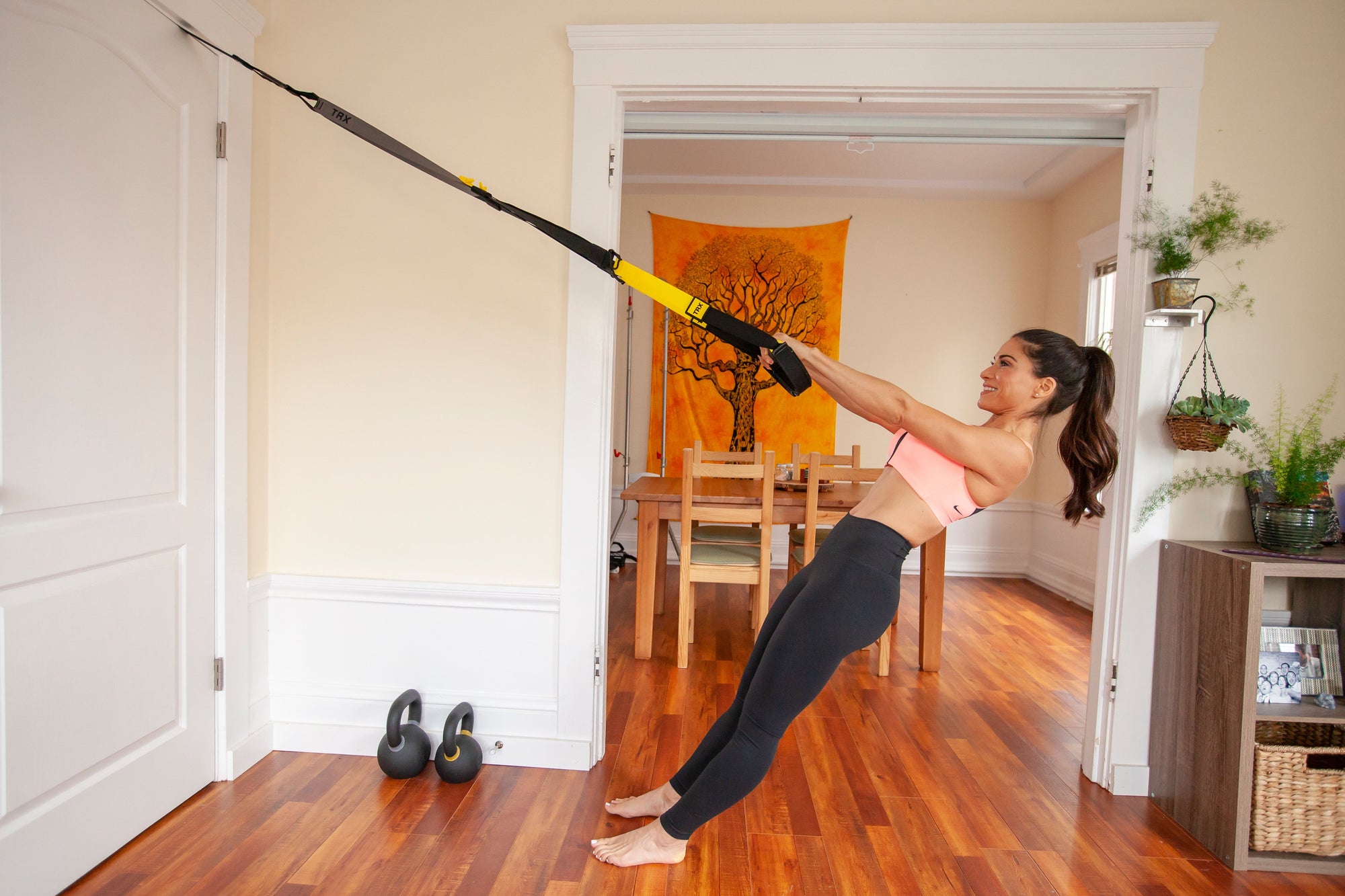
5 TRX Skills for Training Beginners
Clients hire a personal trainer because they want the building blocks for long-term fitness. When you start coaching a new client, it's important to make sure they have a handle on the basics. Take our quick form assessment quiz to get personalized tips for teaching these fundamentals. To help, we're going over five TRX skills every beginner should know to get the most out of their TRX Experience.
TAKE OUR TRAINING QUIZ
Adjusting the Straps
The TRX Suspension Trainer is the most versatile fitness tool on the market, but that doesn’t mean that every client intuitively understands how to adjust the straps. If you’ve ever taught a TRX group class, you know that even some long-time TRX devotees struggle with adjusting the Suspension Trainer.
Particularly if you’re working with clients virtually, take a few minutes to go over how to set up the Suspension Trainer, adjust the strap length, adjust the foot cradles, and place toes and heels in the foot cradles. Those basics will make transitions between moves smooth and stress-free.
TRX Low Row
The moving plank is at the core of most TRX exercises that start standing facing the anchor point. The TRX Low Row is one of the easiest ways to teach proper form for the moving plank because it targets lats, traps, and rhomboids—muscles that tend to be more developed, even in beginner clients.
In addition to teaching the moving plank, you can use the TRX Low Row to demonstrate how to progress and regress an exercise by adjusting the standing width and angle relevant to the anchor point.
TRX Squat
The Suspension Trainer can be a full-body fitness tool on its own, or it can be the training wheels equivalent for strength training—especially when it comes to squats.
Many new clients falsely believe they know how to squat, and correcting bad form can be challenging. (No client likes hearing they’re wrong.) Teaching Suspension Trainer squats gives you leeway to teach proper form because you’re working in a new modality. Establishing that technique early will not only pay off when you introduce variations on the squat, but also when your client attempts weighted squats off the straps.
TRX Chest Press
Much as the TRX Low Row is a great way to coach the moving plank for the standing facing the anchor exercises, the TRX Chest Press is the best introduction for exercises standing facing away from the anchor. In addition to playing with progressions and regressions, this is also a good move to demonstrate the offset stance for clients who are pregnant or coping with injuries.
TRX Plank
Want to give your new clients a benchmark challenge? Put them in a TRX Plank!
In addition to serving as the base component for a number of TRX exercises—like crunches, runners, pikes, and more—the TRX Plank is excellent for creating body awareness. It gives you an opportunity to coach your clients through the differences that engagement in different muscle groups can make to overall form.
Most TRX newcomers struggle with their planks in the beginning, so this is a smart way to help clients measure their progress. Time how long the client can hold a basic TRX Plank in your first session, then set a goal to increase that duration in each successive meeting.
Anyone can search the internet for a workout plan or download a list of exercises, but a trainer offers expertise and feedback on a client’s form. Coaching your clients through the Suspension Trainer basics at the beginning will give them a foundation for long-term success.
To learn more about TRX tips and tricks for coaching clients, check out TRX Education.
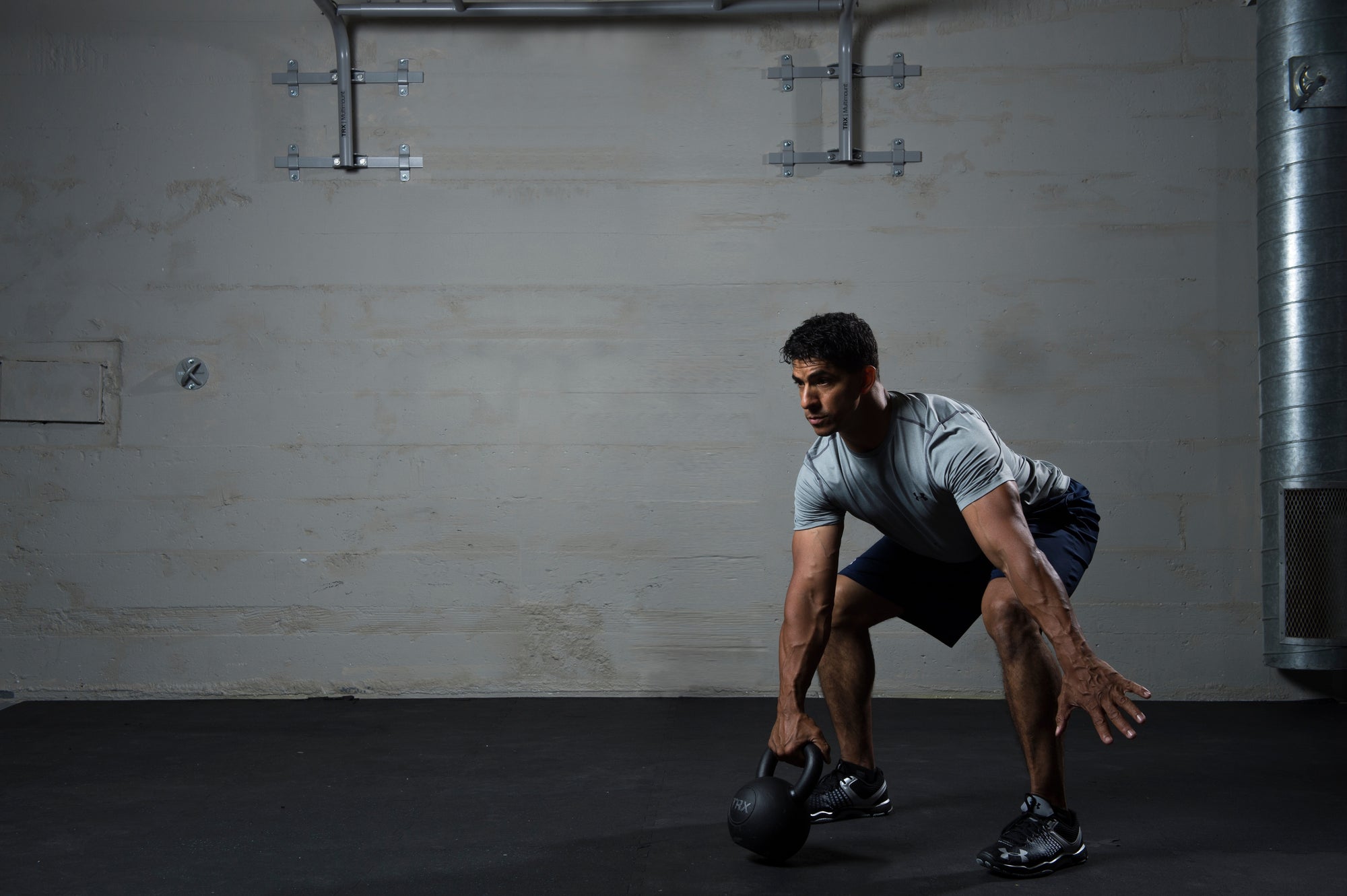
The 4 Best Kettlebell Exercises for Beginners
The biggest obstacle to breaking in new workout gear is usually deciding where to start. So let’s alleviate that decision paralysis right now. When you’re looking for ways to begin working with your TRX Gravity Cast Kettlebells, turn to these four beginner moves.
But first, Kettlebells 101
A kettlebell has more parts than you might expect for a solid chunk of metal, and learning what to call all of the whatsits will help you understand basic kettlebell exercises.
Think of the top grip of a kettlebell as a giant “C.” The center bar of the grip is called the handle, while the curves at the sides of the handle are known as the corners. The tips of the “C”—where the kettlebell connects to the bulb that accounts for most of the weight—are known as the horns. The horns connect to the bell, and the flat bottom of the bell is called the base.
TRX Kettlebells are gravity-cast with a smooth, powder-coated finish to ensure that the burn you feel comes from your workout, not from friction in your grip.
Speaking of workouts, let’s get down to business.
Hey! I want to do a Turkish Get-up!
Don’t we all?
Patience, young padawan. You have to nail the fundamentals before you progress into the advanced moves. It’s also important to remember that moving with a kettlebell may feel awkward when you’re getting started. That’s because a kettlebell is designed to engage in its own trajectory of movement that complements your movement.
Think of it like walking with a full glass of water: with each step, the water is going to engage in its own pattern of movement; maybe even slosh over the glass. Similarly, a kettlebell’s handle is meant to rotate as an axle inside your grip. One of the reasons that kettlebell workouts are effective is your body has to respond to and counterbalance the kettlebell’s independent momentum.
In other words, it’s best to start with the simple exercises to understand how exercising with a kettlebell feels before charging into the advanced challenges.
Let’s give it a go.
The Kettlebell Deadlift
Start with your feet hip-distance apart, and your TRX Kettlebell on the ground in front of your toes. Hinge at your hips, pushing your butt back as you do, and try to minimize the bend in your knees. Grab the kettlebell handle by the corners, and start your return to a standing position. As you straighten your body, you’ll be powering that lift through the posterior chain. (That’s the official name for the muscle groups in your backside.)
Continuing to grip the kettlebell by the corners, and repeat that hinge-and-extend motion. Focus on keeping your back flat and your shoulders pulled down and back. You don’t have to touch the kettlebell to the floor with each rep; if your hamstrings are tight, your terminal point for the deadlift might be around your shins or ankles. That’s okay!
Goblet Clean
In this move, you’ll change your grip on the kettlebell while maintaining fluid motion.
Start again with feet at hip-distance and the kettlebell slightly in front of your toes. Squat down and grab the kettlebell by the corners. Your palms should be facing your legs.
There are two elements to think about as you return to full extension: first remember to power that standing motion from your posterior chain.
Second, as you lift the kettlebell, use the momentum to propel your grip change. Drop your elbows toward your hips. As your elbows drop, your palms will slide to the horns of the kettlebell and lift the kettlebell in the process. (This is one of those exercises where the smooth finish of the TRX Kettlebell really pays off.) The kettlebell should be by your chest at the top of this motion.
When you repeat the exercise, dropping back into your squat, slide your grip back to the corners.
Dead Stop Swing
Start in your deadlift position: Feet hip-width apart, and the kettlebell slightly in front. When you hinge to grab the handle, your hands should be slightly in front of your shoulders.
To set the shoulders and the upper back, imagine you’re trying to snap the kettlebell handle in half. Hike the kettlebell from the floor into the backswing position, so the corners of the handle hit your upper thighs, just under your crotch. Pop your hips forward, swinging the kettlebell up to shoulder height, before letting gravity return the kettlebell back to your upper thighs.
Because this is a Dead Stop Swing, it’s a punctuated motion. The kettlebell trajectory for each rep goes floor, thighs, shoulder, thighs, floor.
Kettlebell Swing
Once you’ve got the hang of the Dead Stop Swing, it’s time to move on to the Kettlebell Swing. Start in your deadlift position. Hinge at your hips and reach forward to grab your kettlebell by the handle. Hike the kettlebell into the backswing position.
This time, the kettlebell’s trajectory will be a pendulum motion between the upper thighs and the shoulder. This movement is still being powered by your posterior chain, so focus on hinging and thrusting through your glutes and hamstrings instead of lifting with your shoulders.
All together, now!
You’ve got four kettlebell exercises for beginners to get your routine started, so why not combine them into a workout? Try this one on for size!
30 seconds: Kettlebell Deadlifts
15 seconds: Rest
30 seconds: Goblet Cleans
15 seconds: Rest
30 seconds: Dead Stop Swing
15 seconds: Rest
30 seconds: Kettlebell Swing
15 seconds: Rest
Repeat the entire kettlebell circuit for a second round, and you’ve got a solid workout in less than 8 minutes.
And if you’re ready for even more kettlebell instruction, check out the full library of on-demand kettlebell workouts from TRX Training Club. With more than 30 workouts (and counting), there’s always an option to keep your training on track. Never tried TRX Training Club? Your first week is free, so get started today.
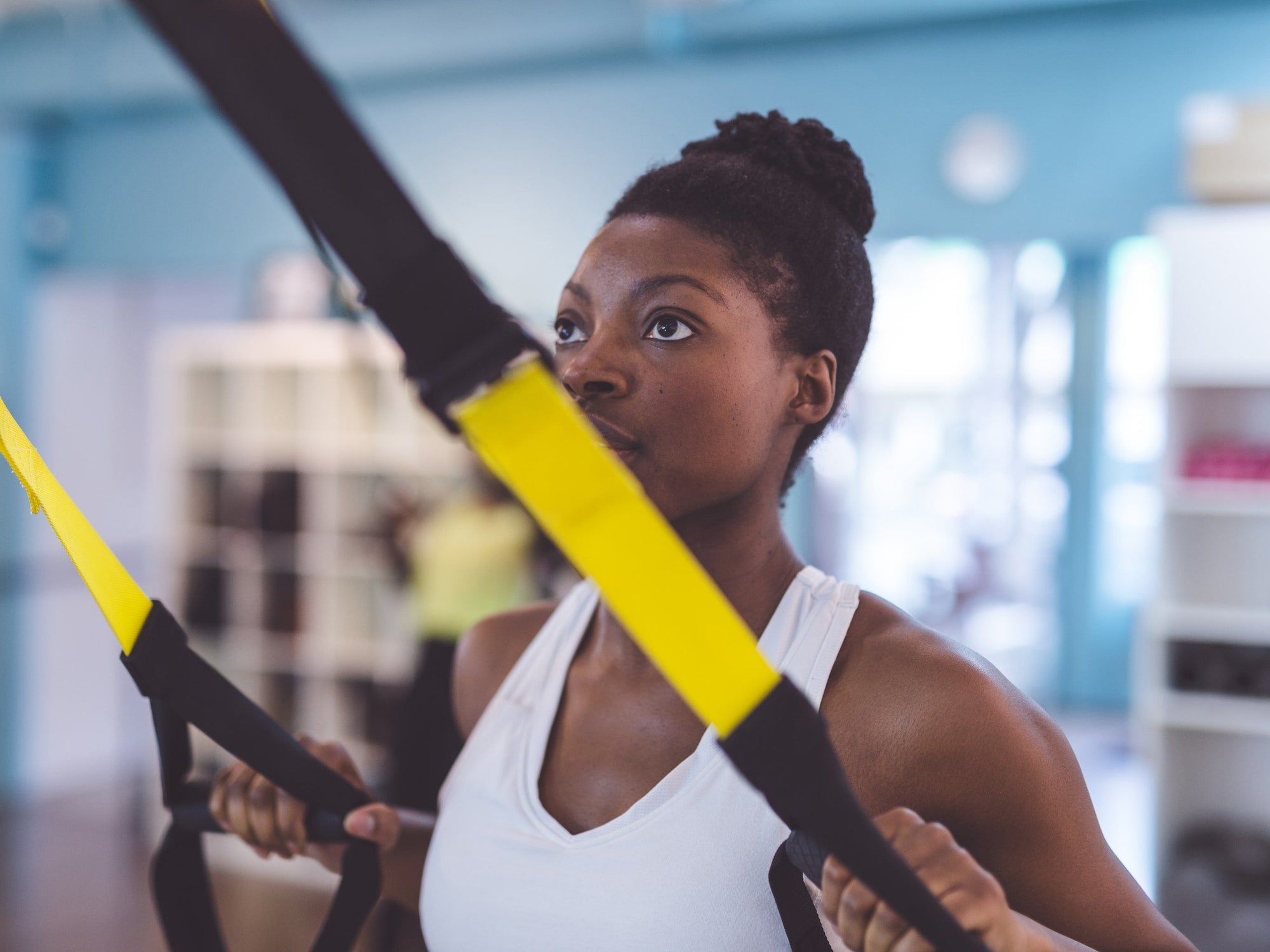
The 5 Best Foods to Eat after a Workout
Studies show that eating the right foods within 30 minutes of a workout can reduce inflammation, replace glycogen stores for future workouts, and repair muscle damage. Want personalized nutrition recommendations for your workout routine? Take our quick assessment quiz to get a customized post-workout meal plan. While many people turn to processed recovery drinks to refuel, the best recovery foods come in the form of whole foods. Here are five of my favorites.
TAKE OUR TRAINING QUIZ
1) Eggs: Protein is critical when bouncing back from a workout, and eggs are a perfect source. In fact the quality of egg protein is the highest of any whole food product. They contain, with varying amounts, 13 essential vitamins and minerals. Eggs are one of the only foods that naturally contain Vitamin D, which is critical for bone health and immune function.
2) Cherries: Exercise naturally involves muscle damage, inflammation, and oxidative stress that often results in aches and pains. Tart cherries, which contain concentrated amounts of anthocyanins, seem to help with all three issues. Findings suggest that tart cherry juice has the ability to reduce muscle pain and weakness after intense strength training, as well as after long-distance running.
3) Ginger: Ginger has been used for centuries as a painkiller. It is a rich source of powerful antioxidants that include gingerols, shogaols and zingerones. It has also been shown to help decrease inflammation. In fact, a study in the Journal of Pain shows that ginger may aid in reducing muscle soreness. Athletes who ate ginger were found to experience less delayed-onset muscle soreness compared to those who did not.
4) Grains: You have probably have heard about the importance of eating carbohydrates before a workout, but consuming them after is equally important. Carbohydrates replenish your depleted glycogen levels, giving you energy and helping your body fight fatigue. Quinoa, oats, brown rice and other whole grains are top options.
5) Salmon: Research suggests that the omega-3 fatty acids found in salmon may help reduce post-exercise muscle inflammation. Specifically, it appears that they lower the amount of prostaglandin, a naturally produced compound in the body that can trigger inflammation. Additionally, salmon is packed with lean protein, which is essential in cell generation and promotes muscle repair. Looking for vegetarian sources of omega-3s? Walnuts, chia, and flax seeds are all good sources of these fatty acids.
Most people don’t realize the importance of refueling their bodies after a vigorous training session. My clients often tell me that they don’t feel like eating after working out. A subscription meal service like Sun Basket makes it easy to get a healthy meal on the table fast. Experiment by including some of the above ingredients in your post-workout meal. . . Your body will thank you when it's time for the next training session.
5 Great Recipes You Should Eat After a Work Out
Salmon with tomato ginger chutney and cardamom rice
Warm quinoa salad with sour cherries and shiitakes
Turkey ginger meatballs in shiitake mushroom broth
Paleo sour cherry and mixed nut granola
Steak and eggs with tomato cauliflower “rice”
Kaley Todd is Sun Basket’s registered dietitian and the culinary nutritionist. Her goal is to inspire consumers to adopt healthy eating patterns that are easy, attainable, fun and enjoyable. She provides the tools and guidance to make healthy eating convenient, affordable and delicious.
Do your next workout with our TRX equipment:
TRX® PRO4 SYSTEM
BUY NOW
TRX® HOME2 SYSTEM
BUY NOW
TRX® TACTICAL GYM
BUY NOW
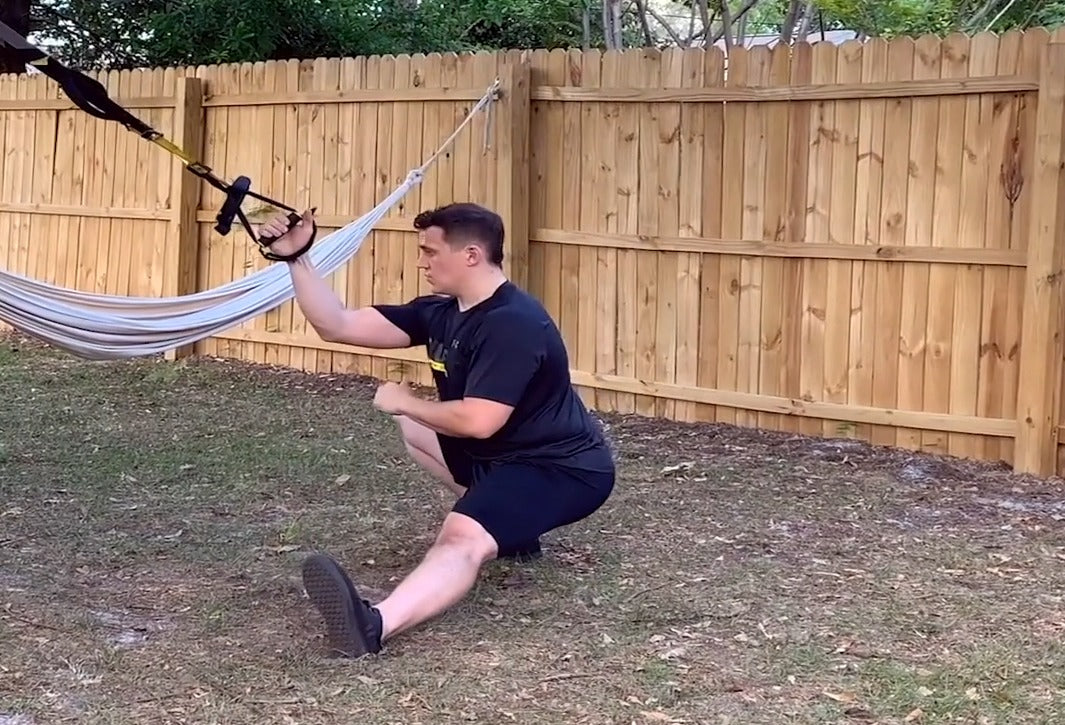
Take It Outside: TRX Moves of the Week
Ready to take your TRX Moves of the Week outside? This week, TRX Educator and Unconventional Strength owner Jesse Grund is setting up shop in his back yard to share three of his favorite TRX exercises.
If you’re a long-time fan of the TRX Door Anchor set-up, but you’re curious about venturing into the great outdoors, Grund is sharing everything you need to know about setting up your Suspension Trainer on a tree or basketball pole.
When setting up on a vertical anchor point like a tree, light pole, or basketball goal, take the strap, wrap it horizontally around the post or tree trunk, and thread the small-looped end through the wider loop of the Suspension Anchor. (Pro-tip: The Suspension Anchor is the short yellow strap. Don’t confuse it with the Door Anchor, which has black pillow-like cushion on one side.) Give the end of the Suspension Anchor a tug in the direction you’ll be working to ensure the anchor is properly secured. Clip the carabiner from your TRX Suspension Trainer through that narrow loop on the Suspension Anchor, and you’re ready to work.
Grund’s exercise picks this week are full body movements that guarantee effort from every muscle group: a TRX Overheard Squat to Y-Fly, TRX Squat to Bicep Curl, and the TRX Power Pull to Cossack Lunge. For all three of these moves, your TRX Suspension Trainer should be adjusted to mid-length, and you will stand facing the anchor point.
TRX Overhead Squat to Y-Fly
Grip the Suspension Trainer handles with your palms facing down, and your body locked in a standing plank. To increase the weight-load, take a step forward; to reduce it, take a step back. Keeping your arms and body straight, pull the handles overheard, so your hands are reaching straight above you. Next, with your upper body and core engaged, drop into a squat. While you lower and raise up from the squat, keep your arms straight above you; don’t release your upper body tension. Once you’ve returned to the standing position, lower your arms down to chest level, and repeat the move.
TRX Squat to Bicep Curl
For this move, Grund is keeping the squat, and swapping out the Y-Fly for a TRX Bicep Curl. Once again, start with straight arms and your palms facing down. This time, you’ll begin by bending your knees and dropping your butt toward the ground for your squat. Keep your weight planted in your heels, and use your glutes and hamstrings to drive back up to your standing position. Once your legs are straight, flip your palms up toward the sky, and—keeping your elbows high and steady on an imaginary shelf—pull the handles toward your temples or ears before gradually releasing back down to straight arms. Remember, your body should remain in a straight line from your ears to your hips to your heels while you do that bicep curl. Flip your palms back to the ground to repeat the combo.
TRX Power Pull to Cossack Lunge
Convert your Suspension Trainer to single-handle mode by threading the free handle through the triangle of the handle you’re using. Start with your single handle in your right hand, your hips squared to the anchor point, and your right arm fully extended. (For this move, pay extra attention to your core engagement to keep your hips from rocking.) The first half of this move is a single-arm row. While executing the row with your right hand, you’ll reach your free left hand to the top of the Suspension Trainer. Your right elbow should remain close to the right side of your rib cage through this move.
As you lower down from that Power Pull, keep your left heel planted and step your right foot out to the right side. Sink down on the right leg, while keeping the left leg straight for a side lunge. Planting your right foot into the ground, drive back up to your standing position, and bring the right foot back to its original position before repeating the rep.
Don’t forget to balance out the sides by repeating the TRX Power pull to Cossack Lunge on the left side. Remember, when you’re holding the handle in your left hand, your right heel will stay planted and your left foot will step to the side for your lunge.
Inside or outside, TRX is here to challenge you to stay healthy and strong. For more moves from Jesse Grund and TRX pros from around the world, be sure to follow TRX Training on Facebook and Instagram.
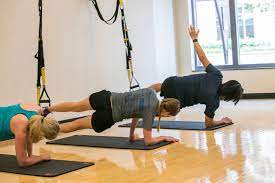
Summer HIIT Workout: TRX Summer Salutation Series
Crank up the heat on your summer body with this short, sweet and sizzling-hot HIIT workout you can do anywhere. Excellent for anyone who doesn’t have much time but still wants to get great results, this high-intensity interval training workout gets your heart rate up and your waistline down.
Perform each exercise for 60 seconds resting only to transition to the next exercise. Perform the entire sequence one to three times through.
TRX Sprinter StartStand facing away from the anchor point holding the handles with your hands next to your chest and the straps under your arms. Walk your feet back until your body is at a 45-degree angle. Reach back with one leg until your working leg is bent at a 90-degree angle. Drive through the ball of your working foot to return to the start.
TRX Inverted Row Face the TRX Suspension Trainer with your chest directly under the anchor point, holding on to the handles with your palms facing each other. Bend your knees to 90 degrees, brace your core and squeeze your glutes. Draw your shoulder blades together and use your lats to pull your body up until your hands are at the side of your rib cage. Slowly lower your body back down to the start position.
TRX Hamstring RunnerLay on your back with your heels in the foot cradles, directly under the anchorpoint. Press your heels down and brace your core to lift your hips up. Imagine your are performing a plank on your back. Use your hamstring to pull one heel toward your butt, while keeping the other leg straight. Engage your core the entire time. Send your heel back to the start position in one slow and controlled motion and repeat on the other side.
TRX Atomic Push UpStart in a pushup position with your feet in the foot cradles of the Suspension Trainer, directly under the anchor point, and your hands under your shoulders. Brace your core and perform a pushup. When you reach the top of the push up, pause for a moment and perform a TRX crunch, drawing your knees toward your chest and pikeing your hips up slightly. Pause for a moment at the top, then lower your hips back down and straighten your legs to return to the start position.
TRX SkatersStand facing the TRX Suspension Trainer holding the handles with both hands in front of you and your feet together. Jump to your right side and land on your right foot. Control your momentum by letting your knee bend as you land. Hop rapidly from side to side.
Click here to get more great HIIT workouts
HIIT workout with the TRX Rip Trainer
High Intensity Interval Training on the TRX
Part 1 High Intensity Interval Training (HIIT) Workout from Mike Boyle
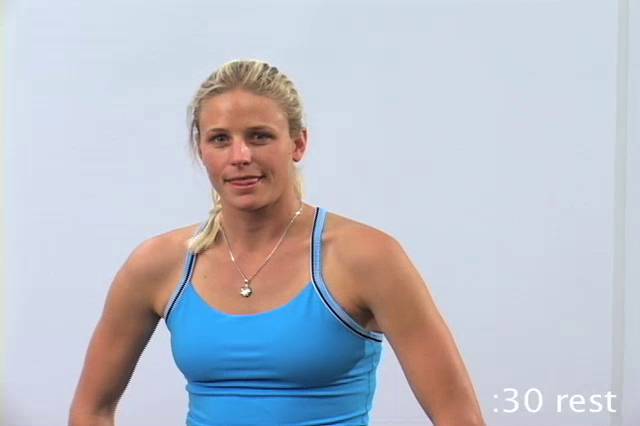
Surf Stronger with TRX Training
With the Rip Curl Pro Search taking place at San Francisco's Ocean Beach this week, we had a chance to speak with Surf Stronger head coach Scott Adams who's been at the competition to see all the action. Take our quick surf fitness quiz to get customized exercises for improving your performance in the water. Surf Stronger is the leading force in surf specific strength and conditioning programs, and Adams, a former collegiate runner, Ironman competitor, certified strength and conditioning coach, and avid surfer, is a huge proponent of the TRX Suspension Trainer for enhancing performance in the water.
TAKE OUR TRAINING QUIZ
“The TRX is perfect for surfing because it’s such a bodyweight based dynamic movement sport,” Adams says, “practically every exercise is going to involve something that will benefit you, with either a core demand or an aligning of the body.”
The face of competitive surfing has changed. Five years ago when Adams was just starting Surf Stronger, it would take some serious convincing to get any surfer to “train” for surfing, but as the level of competition has risen, so has the necessary level of athleticism. These days, Adams says most of the top pros are incorporating some sort of auxiliary work. Adams’ brand of functional strength training for surfing specifically incorporates movements that map to and compliment the way the body is going to move while surfing, instead of isolating a specific muscle group.
“[You’re] not segmenting the body but using the body as a whole, as resistance, and then incorporating dynamic movements.” He likes using the TRX because he says it increases proprioception, lighting up the neuromuscular pathways that his athletes use in the water.
One of Adams’ favorite TRX exercises is TRX Power Pull, which he has modified to incorporate a squat at the bottom. “With surfing, there is so much compression and decompression of the legs. This exercise maps directly to the way you generate speed or land maneuvers while you’re surfing, by compressing the body and then decompressing up the face of the wave,” This movement engages the transverse plane with rotational resistance, which is similar to the way the body is loaded while performing a powerful bottom turn. At the top of the TRX Power Pull, you are incorporating the lats and shoulders, which translates well to paddling and popping up.
Another benefit Adams sees to TRX Training is that virtually every exercise requires bodily alignment and stabilizing from the core in order to remain balanced. Once an athlete has mastered the basic progression, he can instantly challenge his balance by altering his stability, usually by lifting up an arm or a leg. Adams will often have his athletes perform stability work on the beach as part of a warm up before a session for preactivation.
Surfing is not only a sport that requires core strength, stability and explosive power, but also muscular endurance, especially at the elite level we have been seeing at the Rip Curl Pro Search. A typical ASP tournament lasts several days, during which competitors will surf in multiple heats. Adams doesn’t directly train this endurance in a traditional way, by incorporating a cardio-endurance element (like swimming, biking, or running) rather he builds their durability with functional strength training on the TRX. The result is that they are less taxed while surfing and then able to stay in the water longer.
“A well trained surfer can surf more.” Adams says, “You can surf longer sessions, surf more often, and catch more waves. Ultimately, if you can surf more, you will get more time to hone your surfing skill and that is what will make you a better surfer. We sum it up with our phrase: Better fitness equals better surfing.”
The TRX Suspension Trainer is uniquely beneficial to surfing.Buy your TRX Suspension Trainer here.
